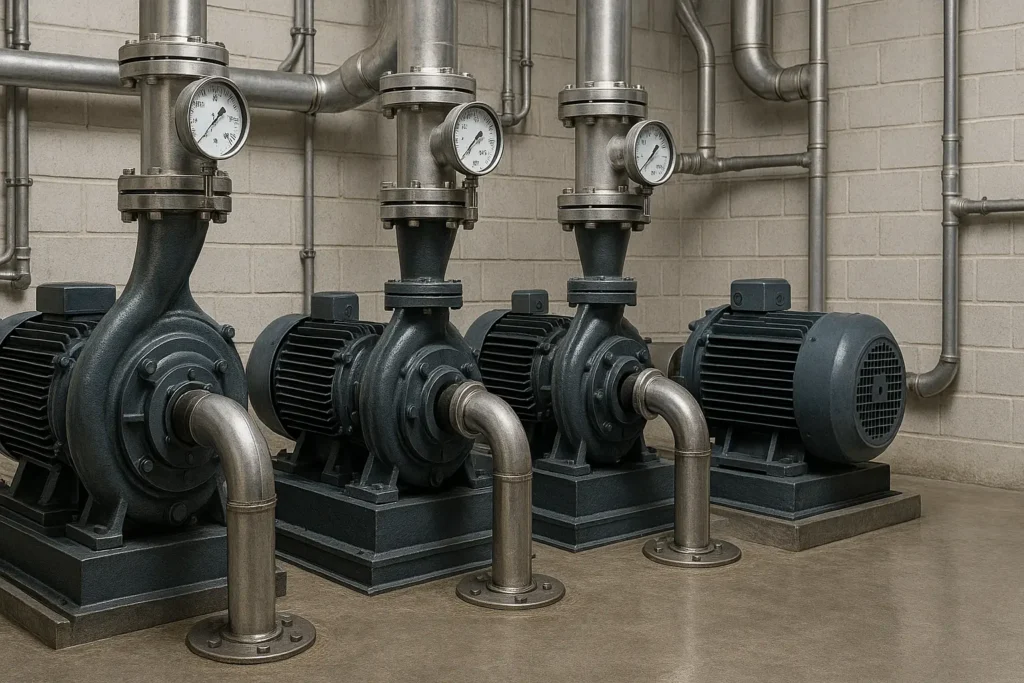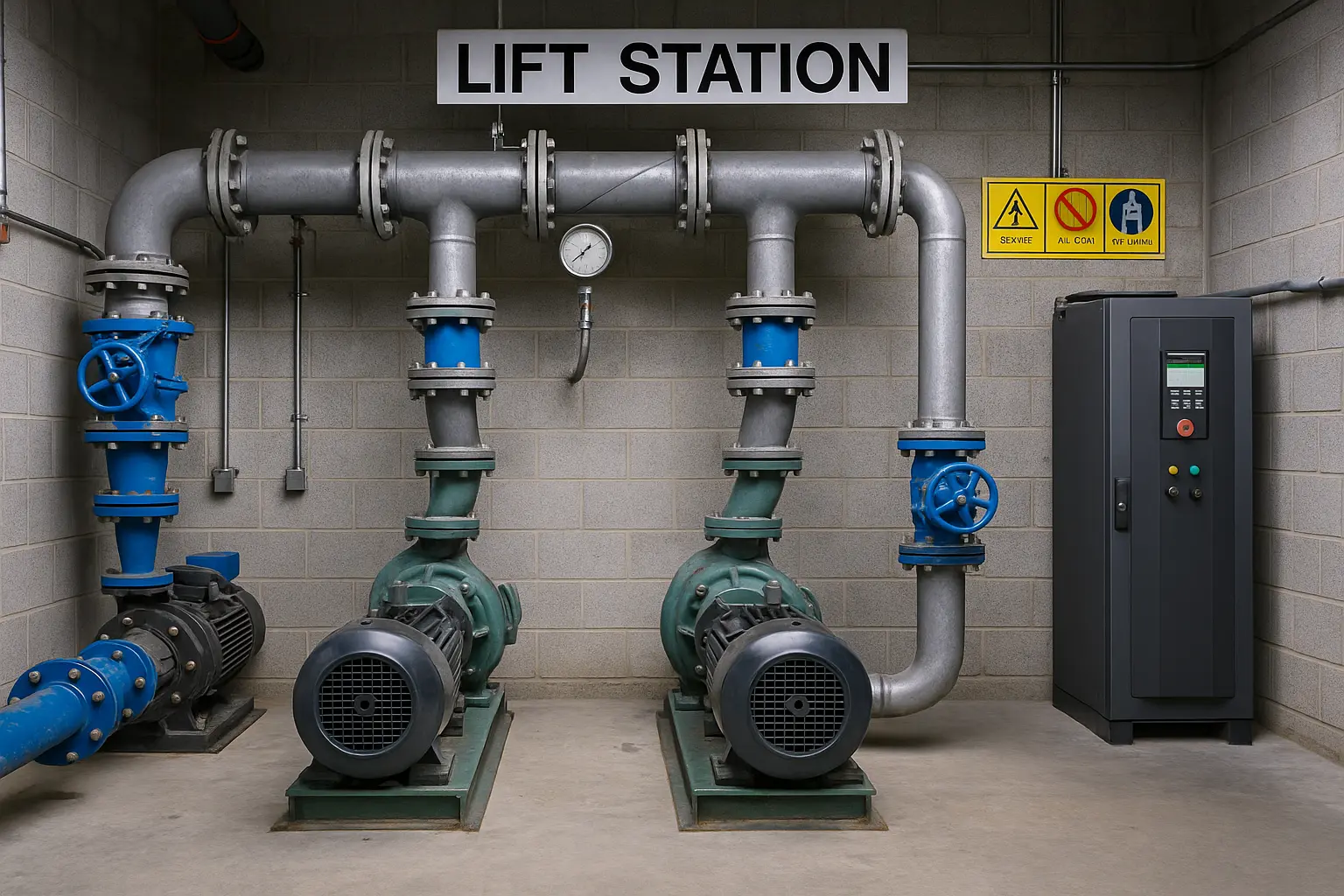Summary: This hands-on guide to wastewater pump troubleshooting shows where pumps fit in the plant, how to diagnose faults in minutes, and how to fix electrical, hydraulic and mechanical issues safely. Includes printable checklists, PM schedules, and an FAQ.
This wastewater pump troubleshooting guide helps operators pinpoint electrical, hydraulic and mechanical faults in minutes.
Reviewed by Stark Water Process Team • Last updated: 20 Oct 2025
1) Where wastewater pumps fit in the process
- Lift & transfer: influent lift stations, equalization tanks, sludge/thickener transfer, backwash/return lines.
- What “reliable” means: operates at design duty point (head & flow), keeps NPSHa > NPSHr + margin, handles solids without clogging, meets thermal limits.
Use this wastewater pump troubleshooting checklist whenever flow, head or amps deviate from the curve.
2) Safety first
Lockout/Tagout. Confirm zero energy (electrical, pneumatic, hydraulic). Wastewater areas may contain methane/H2S—ventilate and monitor. Observe confined-space rules. Protect against splash and hot surfaces.Effective wastewater pump troubleshooting always begins with LOTO and gas monitoring.
Więcej informacji: Hydraulic Institute pump system guidelines -
3) 3-minute quick diagnostics (field matrix)
Use this one-screen matrix to triage 80% of issues before deeper work.
| Objaw | Prawdopodobne przyczyny | First fixes (on site) |
|---|---|---|
| Won’t start / trips | No supply, blown fuse, wrong wiring/rotation, seized shaft or packed stuffing box, thermal overload. | Verify voltage at terminals; reset/replace overload/fuse; free shaft & impeller; check rotation per nameplate; ensure ventilation. |
| No prime / no flow / low flow | Air leak on suction, clogged strainer/foot valve, suction lift too high, worn impeller, valve closed, low RPM. | Seal suction leaks; clean intake; reduce lift or flood suction; open valves; restore rated speed; replace worn hydraulic parts. |
| Overheating motor | Low voltage/drop, overloaded curve (too much head), blocked fan/vents, wrong wiring. | Measure running voltage & amps; correct system head; clean vents; confirm wiring & overload setting match nameplate. |
| High power draw | Bent shaft/misalignment, internal blockage, high specific gravity, wrong duty point. | Align & balance; clear passages; verify fluid properties; shift operating point (valving) or impeller trim. |
| Vibration / noise / cavitation | Unbalance, worn bearings, pipe strain, inadequate NPSHa, resonance. | Rebalance/replace bearings; remove pipe strain; lower suction losses/increase submergence; stiffen base; add flexible joint. |
4) Fault catalog: causes, fixes & prevention
The wastewater pump troubleshooting steps below link each symptom to likely causes and fixes.

4.1 Won’t start or trips immediately
- Checks: supply voltage under load, fuse/MCB rating, control circuit, rotation lock, shaft free-hand turn.
- Poprawka: replace failed protection, correct wiring, free impeller/packing, set overload to 1.0×–1.05× FLA.
- Prevent: keep ventilation paths clear; add soft-start if inrush trips are frequent.
4.2 No prime, no water, or low flow
- Checks: suction joints for air, strainer differential, foot valve submergence ≥ 2× inlet dia, priming integrity.
- Poprawka: re-gasket suction, clean intake, flood suction or add priming pot/ejector, restore design RPM.
- Prevent: keep intake velocity < 0.6–1.0 m/s for dirty water; schedule strainer cleaning.
4.3 Motor overheating
- Checks: line voltage balance, ambient temp, duty point vs curve, enclosure/fan cleanliness.
- Poprawka: stabilize voltage, correct duty (valve or impeller), clean ducts, verify ΔT within OEM limits.
- Prevent: periodic IR/amp trending; dust control; correct cable sizing to reduce drop.
4.4 Excessive power consumption
- Checks: vibration spectrum, alignment, bearing temperature, suction/discharge head.
- Poprawka: align with laser, replace bearings/coupling, remove blockages, re-match impeller to curve.
- Prevent: lock operating window; add flow/head indicators and alarms.
4.5 Vibration, noise & cavitation
- Checks: NPSHa calc, pipe supports, baseplate grout, resonance near 1×–3× running speed.
- Poprawka: lower suction losses, increase submergence, stiffen base/supports, balance rotating assembly.
- Prevent: maintain NPSH margin; install flexible connector; trend vibration.
5) Electrical checks (5 minutes)
- Measure voltage at the motor during start and run; compare to nameplate and design.
- Potwierdzenie rotation oraz wiring per diagram; reset/size overloads correctly.
- Inspect terminations, cable size, and ventilation/fan direction.
6) Hydraulic checks
- Suction health: air leaks, clogged strainer, excessive lift; ensure flooded suction if possible.
- System curve shift: closed valves, fouled piping, head changes; verify against the pump curve.
- NPSH margin: NPSHa ≥ NPSHr + 0.5–1 m (dirty service add margin).
7) Mechanical checks
- Alignment (laser/dial), base grouting, and removal of pipe strain.
- Bearings & seals: temperature, leakage, lubrication schedule; replace when thresholds exceeded.
- Impeller/volute: corrosion/erosion, clearance; correct runout and balance.
8) Preventive maintenance schedule
Data-driven PM shortens future wastewater pump troubleshooting and raises MTBF.
| Interval | Actions | Records (KPI) |
|---|---|---|
| Daily / shift | Read gauges & amperage; verify flow; listen for abnormal noise; check leaks and temperature. | Log flow, head, amps, kWh/m³; remarks. |
| Monthly / quarterly | Verify alignment; clean vents/strainer; lubrication per OEM; insulation resistance test. | Trend vibration (mm/s), IR, insulation MΩ. |
| Annual outage | Pull & inspect impeller; replace bearings/seals if near limits; renew coupling; re-grout if loose. | Service report, parts replaced, next due. |
9) Spares & BOM (ready-to-order)
| Pozycja | Typical spec/notes |
|---|---|
| Mechanical seal kit | Material per service (SiC/SiC, Viton/EPDM); include sleeve, O-rings. |
| Bearings (inboard/outboard) | OEM references; include grease type/interval. |
| Impeller & key | Diameter/trim and material; balance grade G6.3 or better. |
| Gasket set / packing | PTFE/graphite; lantern ring where applicable. |
| Foot/check valve & strainer | Mesh size for solids; submergence guidance. |
| Electrical protection | Fuses/MCBs, thermal overloads sized to FLA. |
10) Commissioning & restart checklist
| Krok | What to verify | Pass/Fail |
|---|---|---|
| Suction readiness | Flooded/primed; strainers clean; valves set; vented air. | □ / □ |
| Rotation | Matches arrow/nameplate. | □ / □ |
| Amperage at duty | Within nameplate FLA; voltage balanced. | □ / □ |
| Flow & head | Agree with curve at operating point. | □ / □ |
| Seals/bearings | No abnormal heat/leak/noise; correct lubrication. | □ / □ |
| Alignment & strain | Final alignment recorded; no pipe strain. | □ / □ |
11) KPIs to track reliability
- kWh per m³ pumped (energy intensity).
- Nieplanowane przestoje hours per quarter.
- MTBF by failure mode (electrical, hydraulic, mechanical).
- Vibration & IR trends against alarm limits.
Trending these KPIs reduces unplanned wastewater pump troubleshooting events.
12) Wastewater pump troubleshooting FAQs
Why does my pump run but produce no flow?
Suction air leaks, blocked intake, closed valves, or severe wear can cause zero flow. Seal leaks, clean intake and verify valves and impeller condition.
How much foot-valve submergence do I need?
As a rule, submerge ≥ 2× the pipe diameter and keep intake velocity < 0.6–1.0 m/s for dirty water to avoid vortices and air entrainment.
What voltage drop is acceptable?
Keep voltage drop ≤ 5% at the motor terminals during run. Excess drop overheats motors and reduces torque.
How can I detect suction air ingress?
Audible hiss, unstable discharge pressure, foamy sight glass, and vibration spikes at low frequency suggest air leaks. Vacuum test the suction line.
When do I rebuild versus replace?
Rebuild if the casing is sound and parts are available; replace when hydraulic efficiency is permanently lost or repair cost exceeds 60–70% of a new unit.
13) Next steps
Upload your pump nameplate, duty point and symptoms—we’ll map the operating point, size spares, and propose fixes.For complex failures, escalate wastewater pump troubleshooting with vibration and IR analytics.
Further reading: Water Environment Federation O&M resources; EPA operator safety guidance.

